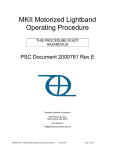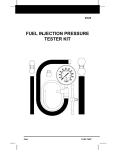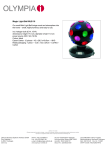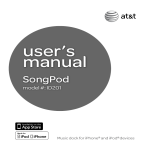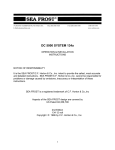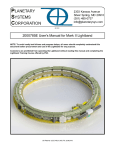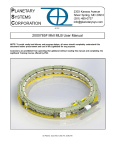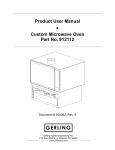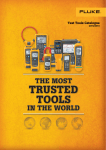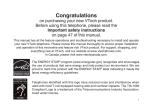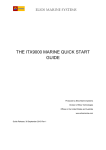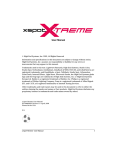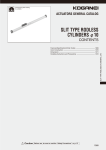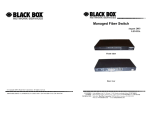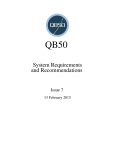Download 2000781F MKII MLB Operating Procedure
Transcript
2000781F MKII MLB Operating Procedure NOTE: To avoid costly test failures and program delays, all users shall completely understand this document before attempting to operate the Lightband for any purpose. Customers are prohibited from operating the Lightband without reading the User’s Manual for Mark II Lightband and completing the Lightband Training Course offered by PSC. Program Name MLB Size (Diameter-Bolts) MLB Assembly Number MLB Assembly Revision MLB Serial Number Technician Name Quality Assurance Name(s) This procedure does not involve any high-energy liquids, solid fuels, or any material with inherently hazardous physical or chemical properties. 2000781F MKII MLB Operating Procedure 12 March 2015 Page 1 of 43 TABLE OF CONTENTS 1. REVISION HISTORY .................................................................................................................................. 3 2. GLOSSARY ................................................................................................................................................ 4 3. INTRODUCTION ......................................................................................................................................... 5 4. WARNINGS ................................................................................................................................................. 9 5. HANDLING PRECAUTIONS .................................................................................................................... 10 6. LIGHTBAND MECHANICAL ATTACHMENT PROCEDURE .................................................................. 11 7. STOWING THE LIGHTBAND ................................................................................................................... 14 8. SETTING-FOR-FLIGHT THE LIGHTBAND ............................................................................................. 24 9. DEPLOYING THE LIGHTBAND ............................................................................................................... 29 10. REMOVING THE LIGHTBAND FROM ADJOINING STRUCTURES .................................................. 35 11. PREPARING THE MLB TO BE COMPRESSED .................................................................................. 36 12. HORIZONTAL INTEGRATION (OPTIONAL) ....................................................................................... 39 13. LIGHTBAND ELECTRICAL VERIFICATION ....................................................................................... 41 14. BEST PRACTICES AND LESSONS LEARNED .................................................................................. 42 15. SETUP PICTURES ................................................................................................................................ 43 2000781F MKII MLB Operating Procedure 12 March 2015 Page 2 of 43 1. Revision History Rev A Issued 02Nov06 11May07 Created RW RW Reviewed Change Description RW Initial document RW Added details and descriptions for latest MKII revision B C 12July07 21Aug07 RW RH RW RH D 15Oct10 RH WH E 15Apr11 RH WH F 12Mar15 CF WH Changed stow, set for flight, and deploy voltage limits Reduced operating voltages and current, deleted and modified steps, added training verification step, added removal from adjoining structures section - Removed "Approving Authorities" section - Updated pictures to reflect current design - Increased weight to compress Lightband - Increased Stow voltage for 38" Lightbands - Added "Best Practices" section - Updated Required Materials - Added Sections: Warnings, Handling Precautions, Horizontal Integration, Electrical Verification - Increased stow voltage - Expanded Best Practices section - Added voltage and current recording - Expanded procedures - Added and improved figures and changed numbering -Updated Cover Page -Updated Section 2.1 -Updated Figure 1 -Added Figure 2 -Updated Figure 5 -Updated Section 3.2 Required Materials -Updated Section 4 Warnings -Added Section 5 -Added steps 6.1.1 & 6.1.2 -Updated steps 6.1.3 & 6.1.4 -Added step 6.1.5 -Updated steps 6.1.6 & 6.1.7 -Added step 6.1.8 -Updated steps 6.1.9, 6.1.10, 7.1.1, & 7.1.3 -Updated requirement 3 of step 7.1.6 -Updated steps 7.1.8, 7.1.10, & Figure 18 -Added step 7.2.1 -Updated steps 7.2.2 & 7.2.3 -Added step 7.2.7 -Updated step 7.2.8 -Added steps 7.2.9 & 7.2.10 -Updated steps 7.2.11, 7.2.12, & 7.2.13 -Added Figure 19 -Updated Figure 20 & Figure 21 -Updated Table 1: Electrical Parameters now size dependent -Added Figure 23 -Added step 8.1.1 -Updated steps 8.1.2 & 8.1.3 -Added step 8.1.7 -Updated step 8.1.8 -Added step 8.1.9 -Updated steps 8.1.10, 8.1.11, & 8.1.12 -Added Figure 24 -Updated Figure 25 & Figure 26 -Updated Table 2: Decreased first peak current and free-running current, increased time to initially cut power -Updated Figure 28 -Added step 9.1.1 -Updated steps 9.1.2 & 9.1.3 -Added step 9.1.7 -Updated steps 9.1.8 & 9.1.9 -Added step 9.1.11 -Updated steps 9.1.12, 9.1.13, & 9.1.14 -Added Figure 29 -Updated Figure 30 & Figure 31 -Updated Table 3: Decreased first peak current and decreased max motor spin down duration -Added Figure 33 -Added Section 11 -Added note about milliohm meter to Section 13 -Updated Table 4: Tighten allowable motor resistance, decreased maximum resistance through switches. -Updated Tip #1,2,4 in Section 14 2000781F MKII MLB Operating Procedure 12 March 2015 Page 3 of 43 2. Glossary A (or Amps) – Ampere (SI unit of electric current) Atm – Standard atmospheric pressure (unit of pressure) C – Celsius (unit of temperature) CG – Center of Gravity Doc – Document (referring to a PSC internal Document number) DOF – Degrees of Freedom DMM – Digital Multimeter ESD – Electrostatic Discharge I – Current (measured in Amps) IAW – In accordance with in – Inch (unit of length) lbf – Pound force (unit of force) LCT – Lightband Compression Tool LV – Launch Vehicle MBA – Motor Bracket Assembly Mk II – Mark II a model designation of the Motorized Lightband, the MkII is easily identified as having external motors. MLB – Motorized Lightband mtr – Motor OD – Outer Diameter Ohm – SI unit of resistance PSC – Planetary Systems Corporation QA – Quality Assurance R – Resistance (measured in Ohms) Rev – Revision S – Samples Sec – Second (unit of time) SHC – Socket Head Cap (fastener) SN – Serial Number STP – Standard Temperature and Pressure (20°C and 1 Atm) SV – Space Vehicle TVAC – Thermal Vacuum TYP - Typically Vdc – Voltage Direct Current (measure in Volts) W – Watt (SI unit of Power) 2000781F MKII MLB Operating Procedure 12 March 2015 Page 4 of 43 3. Introduction This document describes the steps required to handle and operate the MKII Motorized Lightband (MLB). Training and certification by Planetary Systems Corp (PSC) are required to operate any Lightband. Read this entire document before attempting any procedures. Electrical Verification (Table 1, Table 2 and Table 3) and Motor Bracket Resistance (Table 4) apply only at standard temperature and pressure (STP). Contact PSC to clarify any ambiguity or to answer any other questions. 3.1 Lightband Description The Lightband is composed of two separable halves. The Lower Ring contains the Hinged Leaves, Retaining Ring, Motor Bracket Assembly (MBA) and Separation Springs. The Upper Ring, smaller and lighter, contains the accepting groove into which the Leaves engage. The typical orientation is Lower Ring attached to the launch vehicle and Upper Ring attached to the space vehicle. The electrical interface to operate the Lightband is a DB-9 socket connector on the outside of the MBA. See Figure 3 to Figure 5. For more information on the Lightband see PSC Doc “2000785 User’s Manual for MkII Lightband”. There are three Lightband operations: Lightband Operation Stowing Setting for Flight Deploying Description Mechanically locking the Upper and Lower Rings together by forcing the Hinged Leaves to engage the accepting groove in the Upper Ring. Moving internal components of the Motor Bracket Assembly at low voltage to minimize separation time. Verifies proper Lightband operation prior to deploying. Separating the Upper Ring from the Lower Ring. The Lightband is not ESD sensitive. Figure 1: MKII 15.000-24 MLB shown Stowed 2000781F MKII MLB Operating Procedure 12 March 2015 Page 5 of 43 Figure 2: MKII 15.000-24 MLB shown Deployed (also referred to as separated) Figure 3: Motor Bracket Assembly 2000781F MKII MLB Operating Procedure 12 March 2015 Page 6 of 43 Figure 4: Motor Bracket Assembly Figure 5: Motor Bracket Assembly (shown stowed) 2000781F MKII MLB Operating Procedure 12 March 2015 Page 7 of 43 3.2 Required Materials Qty 1 12 AR 1 2 1 1 2 1 1 1 1 1 AR AR AR 1 1 1 1 1 AR AR Item Power source, 32 VDC, 6.5 A Patch cords (to connect Lightband to power source, minimum 3.5A per line) Ability to compress Lightband (payload, weights, compression fixture) Oscilloscope, 4 channel (Isolated channels preferred but not required) Current probes for oscilloscope, 0.05 - 4.0 A range Adjustable timer relay with trigger, 0.5 - 1.5 sec in 0.1 sec increments Trigger switch (minimum 7A & 32V) 10 ohm power resistor, ≥100 W, used to simulate Lightband motor Digital Multimeter (DMM) with leads DB-9 pin breakout cable to connect to Lightband DB-9 socket breakout cable for Test Circuit Adjoining structure for Upper Ring Adjoining structure for Lower Ring 0.25 inch SHC fasteners (to attach Lower and Upper Rings to adjoining structure) <0.50 inch OD washers (to attach Lower and Upper Rings to adjoining structure) ¼-28 Nuts (if applicable, to attach Lower and Upper Rings to adjoining structure) 3/16 inch hex key (minimum 1.5 inch shank length) Torque wrench (with appropriate fitting), 100-115 in*lbf range Small tweezers to aide in screw handling Caliper with inside jaws to measure Lightband height or go/no-go gage Thermometer Isopropanol Lint Free Wipes 2000781F MKII MLB Operating Procedure 12 March 2015 Make & Model Typically Used by PSC Pomona, Banana to Banana, 18AWG Tektronix TDS 2014B Tektronix A622 Macromatic TD-78122 Dale HL-100-06Z-10R00-J-J Fluke 73III or 77IV (or equivalent) PSC 2000741 PSC 2000741 Sturtevant Richmont CCM-150I PSC 2002486 Fluke 52II (or equivalent) - Page 8 of 43 4. Warnings Violating any of the below shall void PSC Document 1001015 MLB Warranty. 1. ALL technicians completing this procedure shall be trained directly by PSC and given authority to operate their specific Lightband(s) via PSC Document 2000750 Lightband Training Record. 2. The Lightband shall only be operated using this procedure. This procedure shall be filled out for every operation of the Lightband. Steps shall not be skipped or modified. 3. If a Lightband ever fails to operate correctly, PSC shall be contacted immediately for recommendations and troubleshooting techniques. Another operation shall not be attempted without first understanding the cause of the initial failure. 4. ALL bolts shall be used when attaching the Lightband to adjoining structures. Bolts shall not be omitted from any bolt hole in the Lightband. 5. With the Upper Ring not present, the Lightband shall never be powered in the stow direction. This would cause damage by repeatedly slamming the ball nut against a hard stop at high speed and force. 6. During operations, objects shall not be placed and left in-between the Lightband flanges which may inhibit the Lightband from properly stowing. The tolerance on the pre-stowed Lightband height is NOT the same as the stowed tolerance. Common potential objects include wiring harnesses and height gages. 7. The Upper Ring shall be physically separated from the Lower Ring after every deployment. A stow operation shall not be attempted without first inspecting the Lightband. 8. BOTH motors shall always be powered when operating the Lightband. 9. The Lightband shall only be stowed within the temperature range of 10-32°C (50-90°F) 2000781F MKII MLB Operating Procedure 12 March 2015 Page 9 of 43 5. Handling Precautions There are several areas of the Lightband that shall not be touched or allowed to contact other objects. 5.1 Lower Ring 1. Do not touch the portion of the Hinged Leaves that engage the Upper Ring. Do not wipe off the grease during cleaning. See Figure 6. 2. Do not touch the ball screw. Be especially careful when installing fasteners immediately next to the Motor Bracket Assembly. See Figure 7. 3. Do not grab the motors. Do not use the motors to rotate the Lightband. 4. Do not allow the motors to hit or rub against anything. This is especially crucial when rotating the Lower Ring. See Figure 8. 5.2 Upper Ring 1. Do not touch the leaf groove. Do not remove grease from the groove when cleaning. See Figure 6. 2. Do not touch the spring plungers. Do not allow the spring plungers to contact or bump against anything. See Figure 9. Figure 6: Do NOT touch leaf lip or corresponding groove in Upper Ring. Figure 7: Installing fasteners immediately adjacent the MBA 2000781F MKII MLB Operating Procedure 12 March 2015 Page 10 of 43 Figure 8: Do NOT allow motors to contact the table or any other objects. Figure 9: Do NOT touch spring plungers or allow them to contact the table. 6. Lightband Mechanical Attachment Procedure 6.1 Attaching Upper and Lower Rings to Adjoining Structures Step 6.1.1 6.1.2 6.1.3 6.1.4 6.1.5 Procedure Ensure the SN on the Upper Ring corresponds to the SN on the Lower Ring. Record the following: PSC Assy Part Number:_____________________ PSC Assy Revision:____ SN:____ (This can be found on both the Upper and Lower Rings of the MLB) Only PSC trained personnel may operate the Lightband. Verify that the completed training authorizes the operation of this specific Lightband assembly number, revision and serial number. The Lightband is designed to accommodate 0.25 inch socket head cap screws and small pattern washers (< 0.50 inch OD). See Section 14. Have ready the required tools and hardware necessary to attach the Lightband to both upper and lower adjoining structures. Verify that both mating surfaces are flat per the User's Manual for Mark II Lightband (PSC Doc 2000785). Clean mating surfaces with Isopropanol and lint free wipes. 2000781F MKII MLB Operating Procedure 12 March 2015 Date, Time & Initials Tech. QA Page 11 of 43 Step 6.1.6 Procedure Lower ring attachment to adjoining structure for a MLB 15.000-24 only. All other sizes skip to step 6.1.7. Date, Time & Initials Tech. QA The spacing between Leaves is tight and requires a unique attachment procedure. Elevate the Lower Ring off the table to allow all fasteners to hang out the bottom. Place the washer on the Lower Ring prior to inserting the screw. If the screw head rubs, push on each adjacent Leaf Pin to move it out of the way slightly. If the adjoining structure has through holes place the Lower Ring on the structure allowing all fasteners to drop in the holes. If the adjoining structure has threaded holes the fasteners must be inserted gradually. Work around the Lightband, turning each screw a few turns at a time until hand tight. Take care to prevent the screw heads from jamming up into the Leaf Pins. Do not contact the Lightband with the wrench. See Figure 10 to Figure 13. Skip to step 6.1.8. 6.1.7 6.1.8 6.1.9 6.1.10 See Section 14 for method of eliminating this tight fit. If using reduced head diameter SHC fasteners skip this step and adjoin Lightband to structure per step 6.1.7. Lower ring attachment to adjoining structure for all Lightbands except the MLB 15.000-24 (unless using reduced head fasteners). Place the Lower Ring on the adjoining structure. Insert fasteners and washers through mounting holes. It is often easier to place the washer on the Lower Ring prior to inserting the screw. Tighten fasteners until hand tight. Do not contact the Lightband with the wrench. See Figure 11 & Figure 13. Torque all fasteners on the Lower Ring Minimum allowable torque is 70in*lbf. PSC typically torques 100-115 in*lbf. Attach Upper Ring to adjoining structure by inserting fasteners and washers through the counterbores. Tighten fasteners until hand tight. Do not contact the Lightband with the wrench. See Figure 13. Torque all fasteners on the Upper Ring. Minimum allowable torque is 70in*lbf. PSC typically torques 100-115 in*lbf. Figure 10: Pushing leaf pin to side to make room for SHC screw (15.000-24 only). 2000781F MKII MLB Operating Procedure 12 March 2015 Page 12 of 43 Figure 11: Inserting a SHC screw between Leaves on Lower Ring. Figure 12: SHC screw and washer inserted between Leaves on elevated Lower Ring. Figure 13: Separated Lightband halves attached to adjoining structures. 2000781F MKII MLB Operating Procedure 12 March 2015 Page 13 of 43 7. Stowing the Lightband 7.1 Preparing the Lightband to be Stowed Step Procedure Verify that the Upper and Lower Rings are attached to adjoining structures 7.1.1 IAW Section 6. 7.1.2 7.1.3 Date, Time & Initials Tech. QA Inspect the Lightband to verify that it is visually free from damage. Check that all Hinged Leaves are properly latched over the Retaining Ring. Check that the Leaf Retaining Cord is seated in the groove of every Hinged Leaf. See Figure 14 for proper orientation. Verify the Sliding Tube can move fully radially inward such that it contacts the Motor Bracket deploy hard stops. This is required to allow the Lightband to be compressed. See Figure 15. If it cannot, go to Section 11. a) Incorrect Leaf position. b) Correct Leaf position. Figure 14: Verifying Leaf positions. a) Incorrect position (stowed state) b) Correct position (deployed state) Figure 15: Verifying pre-stow Sliding Tube position. 2000781F MKII MLB Operating Procedure 12 March 2015 Page 14 of 43 Step Procedure Verify the system being used to compress the Lightband has a total axial 7.1.4 (XLB) stiffness less than 2,000 lbf/in (the entire loop from the Upper Ring around to the Lower Ring). This applies to a crane system offloading a SV, a compression clamp fixture, etc. An isolation system (if attached to the Lightband) can be included in this stiffness calculation. See Figure 16. Date, Time & Initials Tech. QA This compliance ensures the Lightband is able to expand or contract slightly when being stowed. If the system is overly stiff the Lightband motors will not be able to impart the necessary power required to stretch/compress the system. Verify the lateral (YLB & ZLB) stiffness between the Upper and Lower Rings 7.1.5 is less than 50 lbf/in. 7.1.6 This compliance ensures the Lightband can self-align while stowing and prevent the motors from stalling. If using a payload supported by a crane to compress the Lightband: 1. The Lower Ring shall be level within 0.2 deg. 2. Let the payload hang freely such that the Upper Ring is above all parts of the Lower Ring. The Rings shall be concentric within 0.2 in. 3. The Rings shall be parallel within 0.07 in. These requirements ensure the Lightband can self-align while stowing and prevent the motors from stalling. Bring the Upper Ring and Lower Rings close together in preparation for 7.1.7 alignment checks. Alignment between the Upper and Lower Rings shall be verified prior to or just after the extended Separation Springs have contacted the Upper Ring but before any force is applied to compress the Lightband. Verify the following per Figure 17: 1. Cutout in Upper Ring lines up over Motor Bracket on Lower Ring. 2. ALL Separation Connector/Switch cutouts align. 3. ALL Separation Spring tips protrude through appropriate holes in the Upper Ring. For horizontal integration see Section 11. Figure 16: Verifying compliance in Lightband compression system. 2000781F MKII MLB Operating Procedure 12 March 2015 Page 15 of 43 Figure 17: Aligning the Upper and Lower Rings. 2000781F MKII MLB Operating Procedure 12 March 2015 Page 16 of 43 Step Procedure The Separation Springs are often distributed asymmetrically around the 7.1.8 Lightband to induce tip-off or compensate for an offset CG. Using a central single compression point may not be adequate. Compress the Lightband. This can be achieved by placing weights on the 7.1.9 Upper Ring, offloading the payload, compressing in a fixture, etc. The total applied force shall be 20-30 lbf per Separation Spring. Date, Time & Initials Tech. QA Separation Spring quantity = ________ Minimum force = ____springs x 20 lbf = _____lb Maximum force = ____springs x 30 lbf = _____lb If possible apply the force gradually and check that no Hinged Leaves are caught under the Upper Ring as it compresses. Stop once the minimum force is applied. Note: PSC has designed a Lightband Compression Tool for use when applying this force is impractical (horizontal integration, sensitive payload, etc). See Section 14. Once the minimum force has been applied to the Lightband it is necessary to 7.1.10 verify that the Lightband is properly compressed. Figure 18 shows a cross section of the stowed Lightband. Verify the pre-stow height (distance between flanges) in at least 4 places around the Lightband is 1.333 ±0.010in. If any measurement is not within specification verify proper alignment and compressive force. Increase force as necessary from previous step until Lightband is properly compressed. Do not exceed the maximum force calculated in Step 7.1.9. Figure 18: Verifying Lightband pre-stow height. 2000781F MKII MLB Operating Procedure 12 March 2015 Page 17 of 43 7.2 Stowing the Lightband Step Procedure Voltage and Current for each motor shall be measured and recorded for every operation. This procedure incorporates an oscilloscope to measure and record data. Other methods may be used. Ensure data is measured and recorded at a sample rate of no less than 1,000 samples per second and 7.2.1 resolution of no less than 0.02 Amps and 0.1 Volts. 7.2.2 Date, Time & Initials Tech. QA Caution: If oscilloscope channels share common ground be cognizant of their effect on the circuit. Set up the ‘Stow - Power and Measurement Circuit’ per Figure 19. Voltage and current for each “motor” (resistor) shall be measured. Do not connect the Lightband. Verify the resistance between the power supply and Lightband will be less 7.2.3 than 1.0 ohm for each motor. This applies to the complete loop (power and return). 7.2.4 7.2.5 7.2.6 7.2.7 Set the power supply voltage according to Lightband size. Diameter 31.0 in and greater: 30 to 31 Vdc Diameter less than 31.0 in: 27 to 28 Vdc Set the current limit on the power supply to 6.5 ±0.1 A. Set the timer relay to apply power for 1.5 ±0.05 sec. Set up the ‘Stow - Test Circuit’ per Figure 19. This circuit uses a 10 ohm resistor (≥100 W) to simulate each Lightband motor. Connect the ‘Stow - Test Circuit’ to the ‘Stow - Power and Measurement Circuit’ per Figure 19. When ready, apply power to the circuit and verify the following: 1) The entire voltage and current profiles for both "motors" are measured. 2) Timer relay applies power for specified time. 3) Current for each "motor" is about 1/10 of applied voltage. (I=V/R). 7.2.8 4) Data properly saves (transferable data set; e.g. viewable on computer, picture in focus, etc.). 7.2.9 If any parameters are not met, make the required changes and run the test circuit again. The test circuit may be run as many times as necessary to ensure the power and measurement circuit is performing as required. Upon completion of this step the ‘Stow - Power and Measurement Circuit’ shall not be changed. Ensure the Lightband is in the temperature range specified in Section 4. The Lightband may be damaged if stowing outside of this temperature range. Remove the ‘Stow - Test Circuit’ and connect the Lightband to the ‘Stow – 7.2.10 Power and Measurement Circuit’ per Figure 20. Do not apply power to the Lightband. 2000781F MKII MLB Operating Procedure 12 March 2015 Page 18 of 43 Prepare to stow the Lightband. See Figure 21 and Table 1 for the anticipated current draw and power duration. 7.2.11 7.2.12 7.2.13 7.2.14 7.2.15 When ready apply power to stow the Lightband. If the current limit is reached or the timer relay runs longer than the specified time manually cut power. Contact PSC immediately. A visual inspection of the Lightband may be performed, but do not change configuration. Save the voltage and current profiles for both motors. It is acceptable to take a picture of the oscilloscope screen; however tabulated data and high fidelity graphs are preferred. Figure 21 shows typical stow voltage and current profiles. Complete Table 1 to verify all parameters are within tolerance. Single data point exceedances are acceptable. Also, a slow sample rate may alias data. Do not filter data. Contact PSC immediately if a discrepancy is found. Figure 22 shows the state of the switches in the Motor Bracket Assembly after the Lightband has been stowed. Measure resistance directly at the Lightband's DB-9 socket connector by completing Table 4. See Figure 44. Contact PSC if a discrepancy is found. If weights or a fixture were used to compress the Lightband they may be removed at this time. 2000781F MKII MLB Operating Procedure 12 March 2015 Page 19 of 43 Figure 19: Stow Test Circuit Figure 20: Stow Circuit 2000781F MKII MLB Operating Procedure 12 March 2015 Page 20 of 43 Figure 21: Typical stow voltage and current profiles at P = 1.0 Atm and T = +23 deg C 2000781F MKII MLB Operating Procedure 12 March 2015 Page 21 of 43 Table 1: Stow Electrical Verification Stow Electrical Parameters Allowable MLB Size Item 1 8.000-12 11.732-18 13.000-20 15.000-24 18.250-28 19.848-28 23.250-32 24.000-36 31.600-48 38.810-60 Description First peak current Units A/mtr Min 1.9 Max 3.0 2 Second peak current A/mtr 0.5 1.4 3 Motors powered duration sec 0.55 1.10 1 First peak current A/mtr 1.9 3.0 2 Second peak current A/mtr 0.8 1.5 3 Motors powered duration sec 0.6 1.1 1 First peak current A/mtr 1.9 3.0 2 Second peak current A/mtr 0.9 1.7 3 Motors powered duration sec 0.65 1.1 1 First peak current A/mtr 1.9 3.0 2 Second peak current A/mtr 1.0 1.8 3 Motors powered duration sec 0.65 1.1 1 First peak current A/mtr 1.9 3.0 2 Second peak current A/mtr 1.1 1.8 3 Motors powered duration sec 0.65 1.2 1 First peak current A/mtr 1.9 3.0 2 Second peak current A/mtr 1.2 1.8 3 Motors powered duration sec 0.8 1.2 1 First peak current A/mtr 1.9 3.0 2 Second peak current A/mtr 1.2 2.1 3 Motors powered duration sec 0.8 1.3 1 First peak current A/mtr 1.9 3.0 2 Second peak current A/mtr 1.2 2.1 3 Motors powered duration sec 0.8 1.3 1 First peak current A/mtr 2.15 3.2 2 Second peak current A/mtr 1.6 2.3 3 Motors powered duration sec 0.7 1.3 1 First peak current A/mtr 2.15 3.2 2 Second peak current A/mtr 1.6 2.3 3 Motors powered duration sec 0.7 1.3 2000781F MKII MLB Operating Procedure 12 March 2015 Actual Motor Motor A B Page 22 of 43 Figure 22: Switch state after Lightband has been stowed Figure 23: Motor Bracket Assembly shown stowed 2000781F MKII MLB Operating Procedure 12 March 2015 Page 23 of 43 8. Setting-for-Flight the Lightband 8.1 Setting the Lightband for Flight Step 8.1.1 Procedure Voltage and Current for each motor shall be measured and recorded for every operation. This procedure incorporates an oscilloscope to measure and record data. Other methods may be used. Ensure data is measured and recorded at a sample rate of no less than 1,000 samples per second and resolution of no less than 0.02 Amps and 0.1 Volts. Date, Time & Initials Tech. QA Caution: If oscilloscope channels share common ground be cognizant of their effect on the circuit. Set up the ‘Set-for-Flight – Power and Measurement Circuit’ per Figure 24. 8.1.2 Do not connect the Lightband. May skip this step if no components/wiring were added since stowing. 8.1.3 8.1.4 8.1.5 8.1.6 8.1.7 8.1.8 Verify the resistance between the power supply and Lightband connector is less than 1.0 ohm for each motor. This applies to the complete loop (power and return). Set the voltage at 15 to 16 Vdc. Set the current limit on the power supply to 3.5 ±0.1 A. Set the timer relay to apply power for 1.4 ±0.05 sec. Set up the ‘Set-for-Flight – Test Circuit’ per Figure 24. This uses a 10 ohm resistor (≥30 W) to simulate each Lightband Motor. Connect the ‘Set-for-Flight – Test Circuit’ to the ‘Set-for-Flight – Power and Measurement Circuit’ per Figure 24. When ready, apply power and verify the following: 1) The entire voltage and current profiles for both "motors" are measured. 2) Timer relay applies power for specified time. 3) Current for each "motor" is about 1/10 of applied voltage. (I=V/R). 4) Data properly saves (transferable data set; e.g. viewable on computer, picture in focus, etc.). If any parameters are not met, make the required changes and run the test circuit again. The test circuit may be run as many times as necessary to ensure the power and measurement circuit is performing as required. Upon completion of this step the ‘Set-for-Flight – Power and Measurement Circuit’ shall not be changed. 8.1.9 Remove the ‘Set-for-Flight – Test Circuit’ and connect the Lightband to the ‘Set-for-Flight – Power and Measurement Circuit’ per Figure 25. Do not apply power to the Lightband. 2000781F MKII MLB Operating Procedure 12 March 2015 Page 24 of 43 Step Procedure When ready apply power to set-for-flight the Lightband. The motors will free run for ~1.1 seconds and then the Sliding Tube will move off the stow limit switches. This will be apparent when the current spikes, begins to cycle on and off rapidly and/or chatter is heard coming from the Motor Bracket 8.1.10 Assembly, stimulating an electro-mechanical natural frequency. Date, Time & Initials Tech. QA If the current limit is reached or the timer relay runs longer than the specified time manually cut power. Contact PSC immediately. A visual inspection of the Lightband may be performed, but do not change configuration. Save the voltage and current profiles for both motors. It is acceptable to take 8.1.11 a picture of the oscilloscope screen; however raw data and high fidelity graphs are preferred. Figure 26 shows typical set-for-flight voltage and current profiles. Complete Table 2 to verify all parameters are within tolerance. Single data point 8.1.12 exceedances are acceptable. Also, a slow sample rate may alias data. Do not filter data. Contact PSC if a discrepancy is found. Figure 27 shows the state of the switches in the Motor Bracket Assembly after the Lightband has been set-for-flight. Measure resistance directly at the 8.1.13 Lightband's DB-9 socket connector by completing Table 4. See Figure 44. Contact PSC if a discrepancy is found. 2000781F MKII MLB Operating Procedure 12 March 2015 Page 25 of 43 Figure 24: Set-for-Flight Test Circuit Figure 25: Set-for-Flight Circuit 2000781F MKII MLB Operating Procedure 12 March 2015 Page 26 of 43 Figure 26: Typical set-for-flight voltage and current profiles at P = 1.0 Atm and T = +23 deg C Table 2: Set-For-Flight Electrical Verification Set-For-Flight Electrical Parameters Allowable Item 1 Description First peak current Units A/mtr Min 1.05 Max 1.7 2 Free-running current (average) A/mtr 0.02 0.18 3 Post free-run current rise A/mtr 0.2 1.7 4 Time to initially cut power* sec 1.0 1.3 Actual Motor A Motor B *It is acceptable for 1 motor to exceed the maximum allowed time to initially cut power. 2000781F MKII MLB Operating Procedure 12 March 2015 Page 27 of 43 Figure 27: Switch state after Lightband has been set-for-flight. Figure 28: Motor Bracket Assembly shown set-for-flight 2000781F MKII MLB Operating Procedure 12 March 2015 Page 28 of 43 9. Deploying the Lightband 9.1 Deploying the Lightband Step 9.1.1 9.1.2 9.1.3 9.1.4 9.1.5 9.1.6 9.1.7 9.1.8 Procedure Voltage and Current for each motor shall be measured and recorded for every operation. This procedure incorporates an oscilloscope to measure and record data. Other methods may be used. Ensure data is measured and recorded at a sample rate of no less than 1,000 samples per second and resolution of no less than 0.02 Amps and 0.1 Volts. Date, Time & Initials Tech. QA Caution: If oscilloscope channels share common ground be cognizant of their effect on the circuit. Set up the ‘Deploy – Power and Measurement Circuit’ per Figure 29. Incorporate an adjustable timer relay to precisely control the time power is applied. See Figure 43. Do not connect the Lightband. May skip this step if no components/wiring were added since set-for-flight. Verify the resistance between the power supply and Lightband connector is less than 1.0 ohm for each motor. This applies to the complete loop (power and return). Set the voltage at 24 to 32 Vdc. When possible use the minimum voltage as this maximizes the Lightband’s operating life. Set the current limit on the power supply to 6.5 ±0.1 A. Set the timer relay to apply power for 0.5 ±0.05 sec. Set up the ‘Deploy – Test Circuit’ per Figure 29. This uses a 10 ohm resistor (≥100 W) to simulate each Lightband motor. Connect the ‘Deploy – Test Circuit’ to the power supply. When ready, apply power and verify the following: 1) The entire voltage and current profiles for both "motors" are measured. 2) Timer relay applies power for specified time. 3) Current for each "motor" is about 1/10 of applied voltage. (I=V/R). 4) Data properly saves (transferable data set; e.g. viewable on computer, picture in focus, etc.). If any parameters are not met, make the required changes and run the test circuit again. The test circuit may be run as many times as necessary to ensure the power and measurement circuit is preforming as required. Upon completion of this step the ‘Deploy – Power and Measurement Circuit’ shall not be changed. 2000781F MKII MLB Operating Procedure 12 March 2015 Page 29 of 43 Step 9.1.9 Procedure The Upper Ring shall be constrained during deployment. If separating (allowing the Separation Springs to fully extend) skip to step 9.1.10. If separating is not required, then a force shall be applied to prevent movement of the Upper Ring. Apply a compressive force on the Upper Ring per the calculations below. Date, Time & Initials Tech. QA Separation Spring quantity = ________ Minimum Compressive Force = ____springs x 20 lb = _____lb Maximum Compressive Force = ____springs x 30 lb = _____lb Offload any object heavier than the maximum compression force. Skip to step 9.1.11. If separating (allowing the Separation Springs to fully extend) it is required to 9.1.10 constrain the Upper Ring after the Separation Springs reach end of stroke. Deploy Upper Ring Stops or similar shall be used. See Section 14. If separating with a mass attached to the Upper Ring you must offload the weight of the mass to achieve separation (elongation of Separation Springs). Separation Spring quantity = ________ Maximum Tensile Force = ____springs x 5 lb = _____lb Maximum Compressive Force = ____springs x 5 lb = _____lb If Separation Springs are placed asymmetrically the Upper Ring may not remain parallel to the Lower Ring as the Lightband Separates. If separating a Lightband with Roll Brackets consult PSC on how to constrain the Upper Ring. Remove the ‘Deploy – Test Circuit’ and connect the Lightband to the ‘Deploy 9.1.11 – Power and Measurement Circuit’ per Figure 30. Do not apply power to the Lightband. When ready apply power to deploy the Lightband. The Lightband should 9.1.12 separate in less than 0.1 seconds. The deploy limit switches on the Motor Bracket Assembly will automatically cut power to the motors. If a force was applied per step 9.1.9 the Upper Ring will not move. This force will be removed at a later step, allowing the Separation Springs to extend. If the current limit is reached or the timer relay runs longer than the specified time manually cut power. Contact PSC immediately. A visual inspection of the Lightband may be performed, but do not change configuration. Save the voltage and current profiles for both motors. It is acceptable to take a 9.1.13 picture of the oscilloscope screen; however raw data and high fidelity graphs are preferred. Figure 31 shows typical deploy voltage and current profiles. Complete Table 3 9.1.14 to verify all parameters are within tolerance. Single data point exceedances are acceptable. Also, a slow sample rate may alias data. Do not filter data. Contact PSC immediately if a discrepancy is found. Slowly remove the weight/force on the Upper Ring, allowing the Separation 9.1.15 Springs to elongate. 2000781F MKII MLB Operating Procedure 12 March 2015 Page 30 of 43 Step Procedure Figure 32 shows the state of the switches in the Motor Bracket Assembly after 9.1.16 the Lightband has been properly deployed. Measure resistance directly at the Lightband's DB-9 connector by completing Table 4. See Figure 44. Contact PSC if a discrepancy is found. 2000781F MKII MLB Operating Procedure 12 March 2015 Date, Time & Initials Tech. QA Page 31 of 43 Figure 29: Deploy Test Circuit Figure 30: Deploy Circuit 2000781F MKII MLB Operating Procedure 12 March 2015 Page 32 of 43 Figure 31: Typical deploy voltage and current profiles at P = 1.0 Atm and T = +23 deg C Table 3: Deploy Electrical Verification Deploy Electrical Parameters Allowable Item 1 Description First peak current Units A/mtr Min 1.7 Max 3.5 2 Motor powered duration sec 0.045 0.10 3 Motor spin down duration sec 0.03 0.40 2000781F MKII MLB Operating Procedure 12 March 2015 Actual Motor A Motor B Page 33 of 43 Figure 32: Switch state after Lightband has been deployed. Figure 33: Motor Bracket Assembly shown deployed 2000781F MKII MLB Operating Procedure 12 March 2015 Page 34 of 43 10. Removing the Lightband from Adjoining Structures 10.1 Unbolting the Upper and Lower Rings 10.1.1 Step Procedure Removing the Lower Ring on a MLB 15.000-24 only: All other sizes shall 10.1.1 omit step. 10.1.2 Date, Time & Initials Tech. QA Remove the Lower Ring by reversing step 6.1.6. If adjoining structure holes were threaded, back out the fasteners slowly to prevent jamming the heads against the Leaf Pins. Once all fasteners are loose, hold the washer against the Lower Ring and pull the screw out separately. Push the Leaf Pins to either side if they rub the screw head. See Figure 34 & Figure 35. Skip to step 10.1.3. Removing the Lower Ring on all Lightbands other than a MLB 15.000-24. Remove the Lower Ring by reversing step 6.1.7. 10.1.3 It is often helpful to hold the washer against the Lower Ring while pulling the screw out separately. See Figure 34 & Figure 35. Remove the Upper Ring from the adjoining structure by reversing step 6.1.9. Figure 34: Removing a SHC screw from the Lower Ring, outer view Figure 35: Removing a SHC screw from the Lower Ring, inner view 2000781F MKII MLB Operating Procedure 12 March 2015 Page 35 of 43 11. Preparing the MLB to be compressed The position of the Sliding Tube determines whether the MLB can be compressed. Hence, before the MLB is compressed it is imperative that the Sliding Tube is able to move fully radially inward such that it can contact the Motor Bracket deploy hard stops per step 7.1.3. See Figure 15. Step 11.1.1 11.1.2 Procedure Date, Time & Initials Tech. QA There are a number of possible reasons for executing this section. The most common occurs when unpacking the MLB as it is shipped with the Sliding Tube pre-loaded against the Motor Bracket stow hard stop to inhibit motion during shipping. Set up the ‘Sliding Tube – Power Circuit’ per Figure 38. Do not connect the Lightband. 11.1.3 11.1.4 11.1.5 11.1.6 11.1.7 11.1.8 Verify the resistance between the power supply and Lightband connector is less than 1.0 ohm for each motor. This applies to the complete loop (power and return). Set the voltage at 8 ±0.5 Vdc. Set the current limit on the power supply to 1.8 ±0.1 A. Set the timer relay to apply power for 5.0 ±0.5 sec. Set up the ‘Sliding Tube – Test Circuit’ per Figure 38. This uses a 10 ohm resistor (≥30 W) to simulate each Lightband motor. Connect the ‘Sliding Tube – Test Circuit’ to the power supply. When ready, apply power and verify the following: 11.1.9 11.1.10 11.1.11 Current for each "motor" is about 1/10 of applied voltage. (I=V/R). (This can be verified by reading the voltage and current on the power supply.) If any parameters are not met, make the required changes and run the test circuit again. The test circuit may be run as many times as necessary to ensure the power circuit is preforming as required. Upon completion of this step the ‘Sliding Tube – Power Circuit’ shall not be changed. Remove the ‘Sliding Tube – Test Circuit’ and connect the Lightband to the ‘Sliding Tube – Power Circuit’ per Figure 39. Do not apply power to the Lightband. Manually push the Sliding Tube radially outwards (towards the motors) with one finger when the power is applied to the Lightband. See Figure 36. Ensure nothing is touching the Ball Screw and that your finger is not on the surfaces shown in Figure 37. When ready apply power to move the Sliding Tube. The Sliding Tube will move radially inward until the deploy limit switches on the Motor Bracket Assembly automatically cut power to the motors. If the current limit is reached or the timer relay runs longer than the specified time manually cut power. Contact PSC immediately. 11.1.12 Ensure that the Sliding Tube is able to move fully radially inward such that it contacts the Motor Bracket deploy hard stops. See Figure 15. If applicable, continue to step 7.1.3. 2000781F MKII MLB Operating Procedure 12 March 2015 Page 36 of 43 Figure 36: Properly pushing Sliding Tube radially outward Figure 37: Improperly pushing Sliding Tube radially outward 2000781F MKII MLB Operating Procedure 12 March 2015 Page 37 of 43 Figure 38: Sliding Tube Test Circuit Figure 39: Sliding Tube Circuit 2000781F MKII MLB Operating Procedure 12 March 2015 Page 38 of 43 12. Horizontal Integration (Optional) Horizontal integration may be necessary due to space vehicle (SV) and/or launch vehicle (LV) limitations. This section describes the steps and precautions necessary to ensure proper stowing of the Lightband. 12.1 Compressing the Lightband Date, Time & Initials Step 12.1.1 12.1.2 12.1.3 12.1.4 12.1.5 12.1.6 12.1.7 Procedure Is an isolation system attached to the Lower Ring? If so, it may be easier to stow the Lightband with transition rings, remove the transition rings, and then bolt the already mated Lightband to the LV and SV. Contact PSC for details. Tech. QA The Lower Ring, mounted to the LV, shall be perpendicular to level within ±0.2°. See Figure 40. Micro-adjustment of the SV height, pitch and roll is essential. This can be accomplished with a hydro-set, vernier screws, turnbuckles, etc. The structure supporting the SV (crane, tilt-cart, etc.) shall have sufficient compliance to allow for SV movement when stowing. The vertical stiffness shall be less than 2,000 lb/in. Consider and verify compliance in ALL 6 degrees of freedom (DOF). For instance, will the crane stretch, the tilt cart compress or even be lifted up? Can the SV pitch, roll or yaw as necessary? A load cell shall be installed in-line with the SV support structure. Move the SV close to the LV until the tips of the Separation Springs are close to the bottom edge of the Upper Ring (<0.5 in) but not yet overlapping. Align the Upper Ring to the Lower Ring in translation and rotation. See step 7.1.7 for alignment features. Ensure the springs will not be inhibited from engaging their corresponding holes in the Upper Ring flange. It is essential to align all 6 SV DOF prior to actually compressing the Lightband. See Figure 41. Verify no part of the Lower Ring is contacting the Upper Ring and then record the SV load cell reading:________________ Move the SV closer to the LV until the conical tips of the Separation Springs are <0.10 in from the Upper Ring flange. ALL spring tips shall be centered in their corresponding Upper Ring flange holes. The lower and Upper Rings shall be parallel within 0.02 in. Adjust the SV alignment as necessary. The load cell shall remain within 10 lb of the step 12.1.7 reading. Move the SV closer to the LV until the conical tips of ALL Separation Springs 12.1.9 are engaged and centered in the Upper Ring flange holes. The lower and Upper Rings shall be parallel within 0.01 in. Adjust the SV alignment as necessary. The load cell shall remain within 10 lb of the step 12.1.7 reading. Slowly compress the Lightband. See Section 14 if using the Lightband 12.1.10 Compression Tool (LCT). Continually monitor the load cell. It shall remain within 10 lb of the step 12.1.7 reading. When fully compressed the distance between Lightband flanges shall conform to Step 7.1.10. Also verify that the flange distance at the top, bottom, left and right of the Lightband are within 0.005 in of one another. See Figure 42. 12.1.8 12.1.11 12.1.12 An improperly aligned SV may move up or down, left or right, pitch, roll and yaw during the stow process, requiring additional power that the Lightband motors cannot generate. Proper alignment is essential. Record final load cell reading:________________ Return to Section 7.2 to stow the Lightband. 2000781F MKII MLB Operating Procedure 12 March 2015 Page 39 of 43 Figure 40: Verify Lower Ring is leveled prior to mating SV. Figure 41: Be cognizant of translational AND rotational alignment AND compliance. Figure 42: Verify parallelism of compressed Lightband. 2000781F MKII MLB Operating Procedure 12 March 2015 Page 40 of 43 13. Lightband Electrical Verification Measuring the electrical resistance of components in the Motor Bracket Assembly is essential for verifying proper functionality and diagnosing potential problems. Take the measurements directly at the Lightband electrical interface (DB-9 socket connector). See Figure 44. Motor resistance may vary slightly depending on commutator position. Contact PSC and do not operate the Lightband if any value is out of spec. PSC recommends using a DMM. It will not cause damage to or operate the Lightband. If using a milliohm meter, four wire Kelvin probe system, ensure the test current is <0.01 A to prevent rotating the motors. Table 4: Motor Bracket Assembly Resistance Measurement Motor Bracket Resistances Resistance [ohm] Lightband State Object Being Measured Pin Connections Allowable Motor A 2,4 8.0 - 11.0 Motor B 6,8 8.0 - 11.0 Deploy Limit Switch A 1,2 < 0.3 Deploy Limit Switch B 5,6 < 0.3 Stow Limit Switch A 3,4 > 1E6 Stow Limit Switch B 7,8 > 1E6 Stow Limit Switch A 4,9 < 0.3 Stow Limit Switch B 8,9 < 0.3 Motor A 2,4 8.0 - 11.0 Motor B 6,8 8.0 - 11.0 Deploy Limit Switch A 1,2 < 0.3 Deploy Limit Switch B 5,6 < 0.3 Stow Limit Switch A 3,4 > 1E6 Stow Limit Switch B 7,8 > 1E6 Stow Limit Switch A 4,9 < 0.3 Stow Limit Switch B 8,9 < 0.3 Motor A Deploy Circuit 1,4 8.0 - 11.0 Motor B Deploy Circuit 5,8 8.0 - 11.0 Motor A 2,4 8.0 - 11.0 Motor B 6,8 8.0 - 11.0 Deploy Limit Switch A 1,2 > 1E6 Deploy Limit Switch B 5,6 > 1E6 Stow Limit Switch A 3,4 < 0.3 Stow Limit Switch B 7,8 < 0.3 Measured Post Stow Post Set-For-Flight Post Deploy 2000781F MKII MLB Operating Procedure 12 March 2015 Page 41 of 43 14. Best Practices and Lessons Learned The following is a table of best practices and lessons learned over years of Lightband operation and training. These are not required for proper Lightband operation. Unless noted, PSC will not directly supply any of the items listed below, however the drawings/schematics are available upon request. Tip # Step(s) Best Practice / Lesson Learned References 1 6.1.3 If using #10 fasteners (0.19 in dia) to attach Lightband, PSC requires using shoulder washers to center the fastener. You shall receive permission directly from PSC for use of #10 fasteners on a flight unit. PSC Doc 4000669 2 6.1.6 On the MLB 15.000-24 PSC has used ¼-28 SHC fasteners with the head diameter reduced to 0.340 in. This eliminates the interference fit described in step 6.1.6. PSC Doc 4000845 3 7.1.1 PSC uses custom aluminum transition rings as adjoining structures for all Lightband operations and testing. They provide the necessary stiffness to operate the Lightband and ease attachment to other structures. PSC Doc 2000741 4 7.1.10 Use of a go/no-go gage is easier than calipers to verify the Lightband’s pre-stow height. 5 7.1.9 PSC has designed a Lightband Compression Tool 12.1.10 (LCT) when the necessary force to compress the Lightband cannot be applied (sensitive payload, horizontal integration, etc.). It uses tie-wraps looped around a needle bearing on each Lightband flange. PSC Doc 2002486 PSC Doc 2002159 This item CAN be purchased from PSC. Use of this item may affect Separation Spring location and quantity. 6 9.1.9 PSC occasionally uses custom guide rods (Deploy Upper Ring Stops) to restrain the Lightband during separation. They stop the Upper Ring at full Separation Spring extension. This is helpful if the Lightband cannot be restrained via weights or humans (TVAC testing, etc.). 2000781F MKII MLB Operating Procedure 12 March 2015 PSC Doc 2000843 with O-rings Page 42 of 43 15. Setup Pictures Figure 43: Example of equipment used to operate Lightband and record voltage and current. Figure 44: DMM and DB-9 breakout cable used to measure Motor Bracket Assembly resistance. 2000781F MKII MLB Operating Procedure 12 March 2015 Page 43 of 43











































